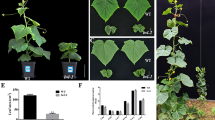Abstract
Two distinct cDNAs for 5-enolpyruvylshikimate-3-phosphate synthase (EPSPS) were obtained from a glyphosate-tolerant tobacco cell line. The cDNAs were 89% identical and the predicted sequences of the mature proteins were greater than 83% identical with EPSPS proteins from other plants. Tobacco EPSPS proteins were more similar to those from tomato and petunia than Arabidopsis. One cDNA clone, EPSPS-1, represented a gene that was amplified in glyphosate-tolerant cells, while the gene for EPSPS-2 was unaltered in these cells. Consequently, EPSPS-1 mRNA was more abundant in tolerant than unselected cells, whereas EPSPS-2 mRNA was at relatively constant levels in these cell lines. Exposure of unselected cells and tobacco leaves to glyphosate produced a transient increase in EPSPS mRNA. However, glyphosate-tolerant cells containing amplified copies of EPSPS genes did not show a similar response following exposure to glyphosate. A significant proportion of the EPSPS gene amplification was maintained when tolerant cells were grown in the absence of glyphosate for eight months. Plants regenerated from these cells also contained amplified EPSPS genes.
Similar content being viewed by others
References
Boocock MR, Coggins JR: Kinetics of 5-enolpyruvylshikimate-3-phosphate synthase inhibition by glyphosate. FEBS Lett 154: 127–133 (1983).
Cullis CA, Cleary W: DNA variation in flax tissue culture. Can J Genet Cytol 28: 247–251 (1986).
della-Cioppa G, Kishore GM: Import of a precursor protein into chloroplasts is inhibited by the herbicide glyphosate. EMBO J 7: 1299–1305 (1988).
Dellaporta SL, Wood J, Hicks JB: A plant DNA minipreparation: version II. Plant Mol Biol Rep 1/4: 19–21 (1983).
Dyer WE, Weaver LM, Zhao J, Kuhn DN, Weller SC, Herrmann KM: A cDNA encoding 3-deoxy-D-arabinoheptulosonate 7-phosphate synthase from Solanum tuberosum L. J Biol Chem 265: 1608–1614 (1990).
Dyer WE, Weller SC, Bressan RA, Herrmann KM: Glyphosate tolerance in tobacco (Nicotiana tabacum L.). Plant Physiol 88: 661–666 (1988).
Gasser CS, Winter JA, Hironaka CM, Shah DM: Structure, expression, and evolution of the 5-enolpyruvylshikimate-3-phosphate synthase genes of petunia and tomato. J Biol Chem 263: 4280–4289 (1988).
Goldsbrough PB, Gelvin SB, Larkins BA: Expression of maize zein genes in transformed sunflower cells. Mol Gen Genet 202: 374–381 (1986).
Goldsbrough PB Hatch EM, Huang B, Kosinski WG, Dyer WE, Herrmann KM, Weller SC: Gene amplification in glyphosate tolerant tobacco cells. Plant Sci 72: 53–62 (1990).
Gubler U, Hoffman NJ: A simple and very efficient method for generating cDNA libraries Gene 25: 263–269 (1983).
Hauptmann RM, della-Cioppa G, Smith AG, Kishore GM, Widholm JM: Expression of glyphosate resistance in carrot somatic hybrid cells through the transfer of an amplified 5-enolpyruvylshikimic acid 3-phosphate synthase gene. Mol Gen Genet 211: 357–363 (1988).
Hollander-Czytko H, Johanning D, Meyer HE, Amrhein N: Molecular basis for the overproduction of 5-enolpyruvylshikimate-3-phosphate synthase in a glyphosate-tolerant cell suspension culture of Corydalis sempervirens. Plant Mol Biol 11: 215–220 (1988).
Klee HJ, Muskopf YM, Gasser CS: Cloning of an Arabidopsis thaliana gene encoding 5-enolpyruvylshikimate-3-phosphate synthase: sequence analysis and manipulation to obtain glyphosate-tolerant plants. Mol Gen Genet 210: 437–442 (1987).
Nafzinger ED, Widholm JM, Steinrucken HC, Killmer JL: Selection and characterization of a carrot cell line tolerant to glyphosate. Plant Physiol 76: 571–574 (1984).
Napoli C, Lemieux C, Jorgensen R: Introduction of a chimeric chalcone synthase gene into petunia results in reversible co-suppression of homologous genes in trans. Plant Cell 2: 279–289 (1990).
Pinto JEBP, Dyer WE, Weller SC, Herrmann KM: Glyphosate induces 3-deoxy-D-arabino-heptulosonate 7-phosphate synthase in potato (Solanum tuberosum L.) cells grown in suspension culture. Plant Physiol 87: 891–893 (1988).
Shah DM, Horsch RB, Klee HJ, Kishore GM, Winter JA, Tumer NE, Hironaka CM, Sanders PR, Gasser CS, Aykent SA, Siegel NR, Rogers SG, Fraley RT: Engineering herbicide tolerance in transgenic plants. Science 233: 478–481 (1986).
Shyr YY, Widholm JM: Glyphosate resistance and gene amplification in selected Daucus carota suspension cultures. In: Nijkamp HJJ, Van derPlas LHW, VanAartrijk J (eds) Progress in Plant Cellular and Molecular Biology, pp. 148–152. Kluwer Academic Publishers, Dordrecht, Netherlands (1990).
Singh NK, Nelson DE, Kuhn DN, Hasegawa PM, Bressan RA: Molecular cloning of osmotin and regulation of its expression by ABA and adaptation to low water potential. Plant Physiol 90: 1096–1101 (1989).
Smart CC, Johanning D, Muller G, Amrhein N: Selective overproduction of 5-enol-pyruvylshikimic acid 3-phosphate synthase in a plant cell culture which tolerates high doses of the herbicide glyphosate. J Biol Chem 260: 16338–16346 (1985).
Smith CM, Pratt D, Thompson GA: Increased 5-enolpyruvylshikimic acid 3-phosphate synthase activity in a glyphosate-tolerant variant strain of tomato cells. Plant Cell Rep 5: 298–301 (1986).
Stalker DM, Hiatt WR, Comai L: A single amino acid substitution in the enzyme 5-enolpyruvylshikimate-3-phosphate synthase confers resistance to the herbicide glyphosate. J Biol Chem 260: 4724–4728 (1985).
Steinrucken H, Amrhein N: The herbicide glyphosate is a potent inhibitor of 5-enolpyruvylshikimic acid 3-phosphate synthase. Biochem Biophys Res Commun 94: 1207–1212 (1980).
Steinrucken HC, Schulz A, Amrhein N, Porter CA, Fraley RT: Overproduction of 5-enolpyruvylshikimate-3-phosphate synthase in a glyphosate-tolerant Petunia hybrida cell line. Arch Biochem Biophys 244: 169–178 (1986).
van derKrol AR, Mur LA, Beld M, Mol JNM, Stuitje AR: Flavonoid genes in Petunia: addition of a limited number of gene copies may lead to a suppression of gene expression. Plant Cell 2: 291–299 (1990).
Author information
Authors and Affiliations
Rights and permissions
About this article
Cite this article
Wang, Y., Jones, J.D., Weller, S.C. et al. Expression and stability of amplified genes encoding 5-enolpyruvylshikimate-3-phosphate synthase in glyphosate-tolerant tobacco cells. Plant Mol Biol 17, 1127–1138 (1991). https://doi.org/10.1007/BF00028730
Received:
Accepted:
Issue Date:
DOI: https://doi.org/10.1007/BF00028730




